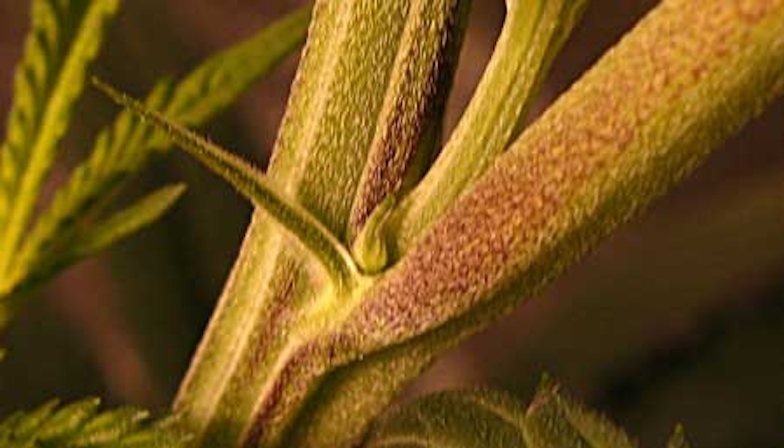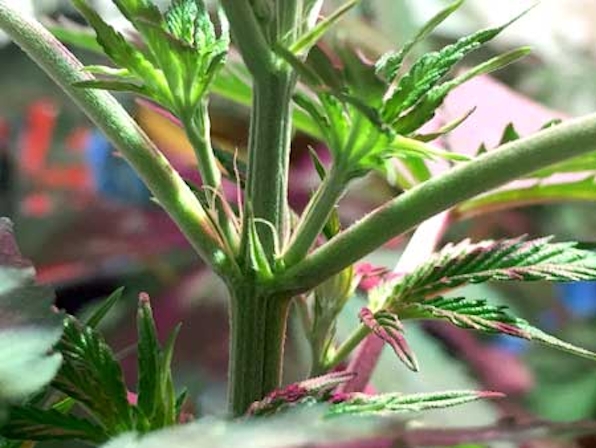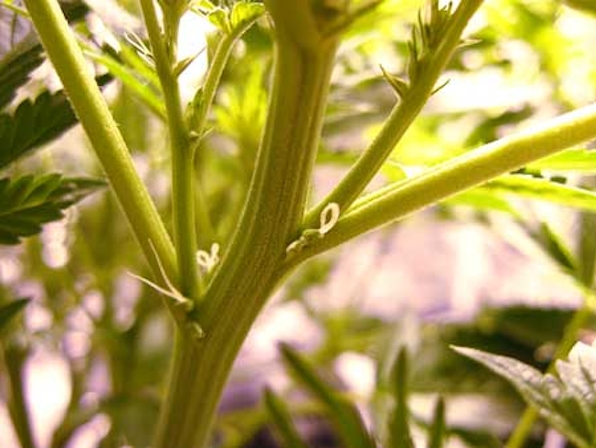
Royal Queen Seeds
5 Clear Early Signs of a Female Weed Plant (Pictures Included)
Spot your female plants early to save them from pollination.
Dealing with regular seeds? It’s pretty exciting to see those first sprouts pop up in your garden.
But figuring out whether those sprouts belong to a male or female plant is the real challenge. Each regular seed can grow into either a male or female plant, and only the females produce the resin-packed buds you actually want to smoke. The tricky part is you won’t be able to tell the difference right away — it takes time for the plants to show early signs of their sex.
If you leave them too long, you risk male plants pollinating female cannabis plants and potentially ruining your entire harvest. To help you stay ahead of it, here’s how to spot the early signs of a female weed plant (with pictures).
Why It's Important To Spot Female Weed Plants

Marijuana Seeds
There are a few reasons why you should identify female weed plants as early as possible:
- Preventing pollination: Male plants release pollen that fertilizes female flowers. Once pollinated, those resin-rich buds start producing seeds instead of staying flower-heavy, which isn’t ideal for many growers after smokable cannabis buds.
- Maximizing harvest: Unpollinated female plants direct all their energy into producing bigger, more potent flowers, rather than wasting energy producing seeds. This means a better chance at a larger yield come harvest time.
- Resource use: Once you’ve spotted female plants, you can focus your time, resources, and effort on those plants instead of wasting resources on unwanted males.
- Make space: Removing male plants (unless you’re using them for breeding) gives your female plants more space to grow and thrive.
Unless you’re breeding new strains, it’s common practice to remove and discard male plants as you see them sprouting up. Most growers prefer all-female gardens since males can quickly throw off an entire harvest if left unchecked.
When Do Weed Plants Show Signs Of Sex?

Grow Weed Easy
At this point, you’re probably wondering, When can I sex my weed plant? Both male and female plants start showing their sex around the pre-flowering stage:
- Photoperiod plants: 3-6 weeks after germination, when light cycles are changed (12/12)
- Autoflowering plants: 3-4 weeks from germination, regardless of light cycle
This is a general timeframe. The exact timing depends on things like strain genetics, growing conditions, and overall plant health. But this window is the absolute best time to spot subtle early signs of plant sex, even before flowering formally begins.
For the most accurate plant sex testing, pay close attention during weeks 4-6 of growth. Female pre-flowers will show more clearly and help you determine cannabis plant sex with a bit more confidence.
5 Early Signs You're Dealing With A Female Cannabis Plant
Female cannabis plants show several unique characteristics that can help you spot them early:
1. Teardrop-Shaped Calyxes

Royal Queen Seeds
One of the first signs you’re looking at a female cannabis plant is the appearance of small, teardrop-shaped calyxes. These form at the plant’s nodes — the points where branches meet the main stem — and act as the base of the flower.
Female calyxes have a more pointed, elongated shape compared to the round, ball-shaped pollen sacs that form on male plants.
If no pollen is introduced, these calyxes will eventually grow into full cannabis buds. Spotting this distinct teardrop shape early is a strong early indicator that you’ve got a female.
2. Pistils (White Hairs)

Marijuana Seeds
Shortly after the calyx forms, tiny white hairs called pistils begin to emerge.
Pistils are actually part of the female reproductive organs, meant to catch pollen from male plants. But unless you’re intentionally breeding, you want to prevent that from happening, since pollination will result in females shifting energy into producing seeds instead of the cannabis buds you desire.
Even a single pistil early on is a strong sign you’re dealing with a female cannabis plant.
3. No Pollen Sacs

Grow Weed Easy
Male cannabis plants have round, ball-like pollen sacs that eventually burst and pollinate all female flowers near them. On the other hand, females won’t have these small, round pollen sacs. Females produce the pointed calyxes mentioned above.
If you don’t see pollen sacs, it’s pretty safe to assume that you have a female on your hands.
4. Bushier Growth Pattern

Royal Queen Seeds
This one isn’t incredibly reliable, but can be helpful along with other early signs. If you notice a plant that’s bushier and more compact compared to the others, it could be an early clue that you’re looking at a female.
Female cannabis plants tend to stay shorter, with tighter internodal spacing (the gaps between branches) and more lateral branching. This structure helps them support heavy bud development later on. Male plants, by contrast, often grow taller and more spaced out. They stretch upward to give their pollen a better chance of traveling through the wind.
5. Thicker Stems

Grow Weed Easy
Since female cannabis plants have to bear the weight of resin-rich flowers, their stems are naturally thicker for support compared to male cannabis plant stems. You can sometimes feel the difference early on: gently wiggle or bend a branch. A female plant’s stem will feel more solid and resist bending, while a male plant’s stem tends to feel lighter, thinner, and more flexible.
What To Do If You Identify A Female Plant

Grow Weed Easy
Once you’ve correctly sexed cannabis plants in your garden, here’s what to do:
Remove Them From Males ASAP
Act fast, or your female marijuana plants could be ruined. If you’ve spotted any male plants or hermaphrodite plants (which have both male and female sex organs on the same plant), separate them from your females immediately. A single male can pollinate an entire grow room. We don’t recommend sexing mature plants—it’s typically too late at that point, and male flowers will soon release pollen.
Optimize Growing Conditions
Female plants that will produce your harvest deserve some good TLC:
- Adjust nutrients: Transition to a flowering nutrient regimen with higher phosphorus and potassium.
- Train plants: Try techniques like LST (Low Stress Training) or SCROG (Screen of Green) to maximize bud sites.
- Watch closely: Watch for signs of stress that could trigger hermaphroditism.
- Maintain ideal environment: Control temperature, humidity, and air circulation for flowering.
Female vs Male Weed Plants: How To Spot The Difference

Royal Queen Seeds
Here’s a quick visual guide to help you further identify female vs male weed plants:
Reproductive Structures
- Female Plants: Pistils (white hairs) emerging from calyxes
- Male Plants: Pollen sacs resembling small balls
Growth Pattern
- Female Plants: Bushier, more compact
- Male Plants: Taller, lankier with fewer leaves
Pre-flower Shape
- Female Plants: Teardrop/pointed calyx
- Male Plants: Round/oval pollen sacs
Appearance Timing
- Female Plants: Generally show sex slightly later (late bloomers)
- Male Plants: Often reveal sex earlier
Stem Thickness
- Female Plants: Typically thicker
- Male Plants: Usually thinner
Here's When To Separate Female and Male Plants

Marijuana Seeds
Immediately. As soon as you spot male plants and are 100% sure you’re correct, the time to separate them from females was yesterday. If you’re still unsure, here’s a timeline:
- First signs of sex: Start planning for separation
- Confirmed sex identification: Separate immediately
- Last safe point: Before pollen sacs open (approximately 1-2 weeks after they form)
Male flowers release pollen once they mature and split open. Even a single opened pollen sac can fertilize multiple female cannabis plants, which will have those fertilized ladies redirecting all energy towards seed production rather than potent bud growth.
How To Identify a Female Weed Plant FAQs

Grow Weed Easy
Need a bit more help learning how to identify a female weed plant? Knowing whether you have male or female plants can be tricky. Here are a few FAQs that growers like you often wonder:
Can you identify female weed seeds before planting?
Nope, not unless you have intense equipment to test the genetics of seeds. In fact, we just wrote an entire guide on the subject and broke down this common myth. The only way to guarantee only female plants is by using feminized seeds. Otherwise, you’ll have to wait for more obvious signs.
How many leaves does a female cannabis plant have?
The number of leaves won’t tell you the plant’s sex. Both female and male plants produce the same type of fan leaves with 5-7 (sometimes up to 9) “fingers” per leaf. Even though females are bushier and males are taller with spaced out leaves, the leaf count and structure are more determined by genetics and growing conditions rather than the plant’s sex.
What does a female weed plant produce?
The dank cannabis buds many weed users know and love. Female cannabis plants produce resin-rich flowers that are packed with cannabinoids like THC and CBD. However, the only way to obtain these potent buds is to keep them unpollinated and away from male plants.
What does a female plant look like fully grown?
A mature female plant in full flower mode will look absolutely stunning. She’ll display dense formations of buds, which should be covered in trichomes and dark pistils (either orange, red, or brown as the plant matures). At this time, she should have already focused her growth energy on bud production rather than vertical growth and seed production.
What happens if you don’t remove male cannabis plants from females?
Destruction, heartbreak, and a whole lot of wasted time (and resources). If males aren’t separated from females, they will release pollen that fertilizes the female flowers and triggers seed production. As mentioned, pollinated female plants redirect their energy away from cannabinoid production and toward seed development. The result? Way too many seeds to make it a quality smoke.
Can a female weed plant turn male?
Not quite. A female weed plant can’t change its genetics to turn male. However, hermaphroditism can happen. A female cannabis plant can start to develop male parts like pollen sacs, which can burst and self-pollinate the same plant and other females nearby. This usually happens due to stress, genetic instability, or other environmental factors.
Why does my female weed plant have seeds?
We hate to be the bearer of bad news, but female plants producing seeds isn’t a good sign for your harvest. Here’s why it happened:
- Hermaphroditism: Your female plant may have developed male pollen sacs due to stress.
- Hidden males: A male plant might be nearby, even in a neighbor’s garden, if growing outdoors.
- Contamination: Pollen from outside plants could have been introduced on clothing or through ventilation.
- Rodelization: Some females produce small amounts of pollen when kept in flowering too long.
Do autoflowering plants show sex earlier?
Yes, autoflowering plants often show their sex earlier than photoperiod plants—usually 3-4 weeks after germination. That’s because autoflowering plants have a faster life cycle, which completes in just 8-10 weeks. The trade-off? You have less time to spot and separate males from females before it’s too late.
Herb Recommended Products:
READ MORE










